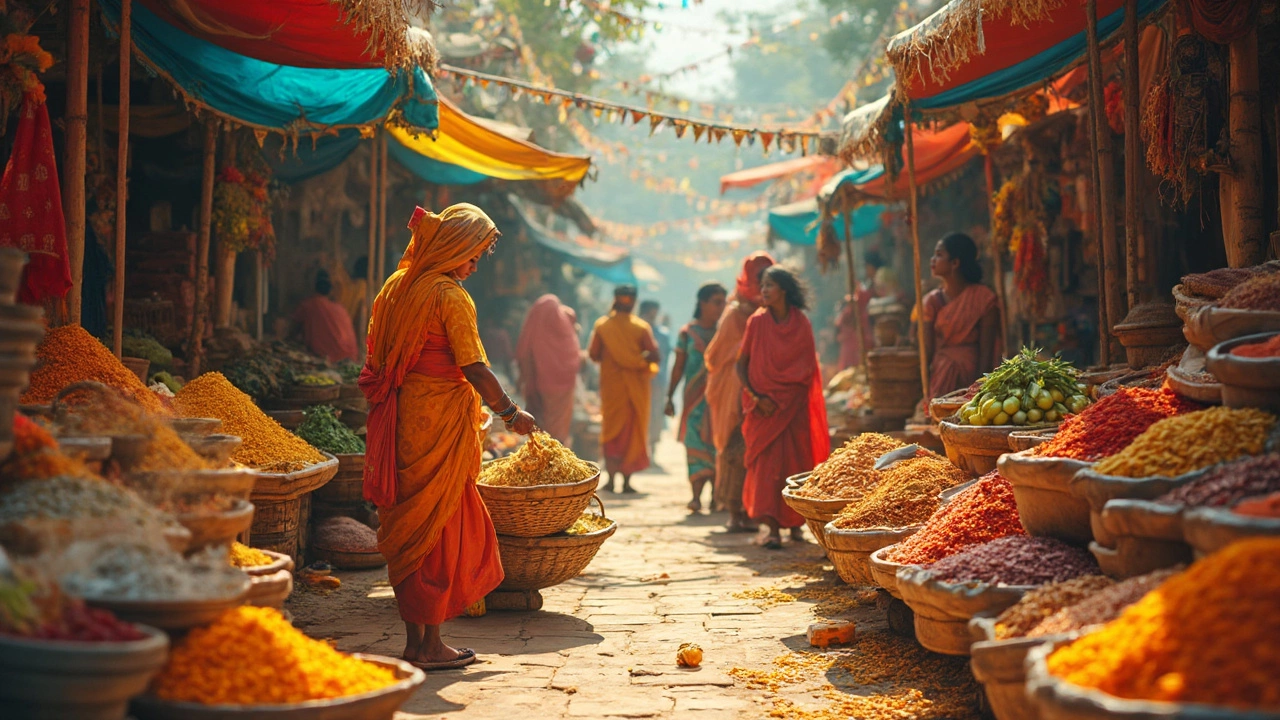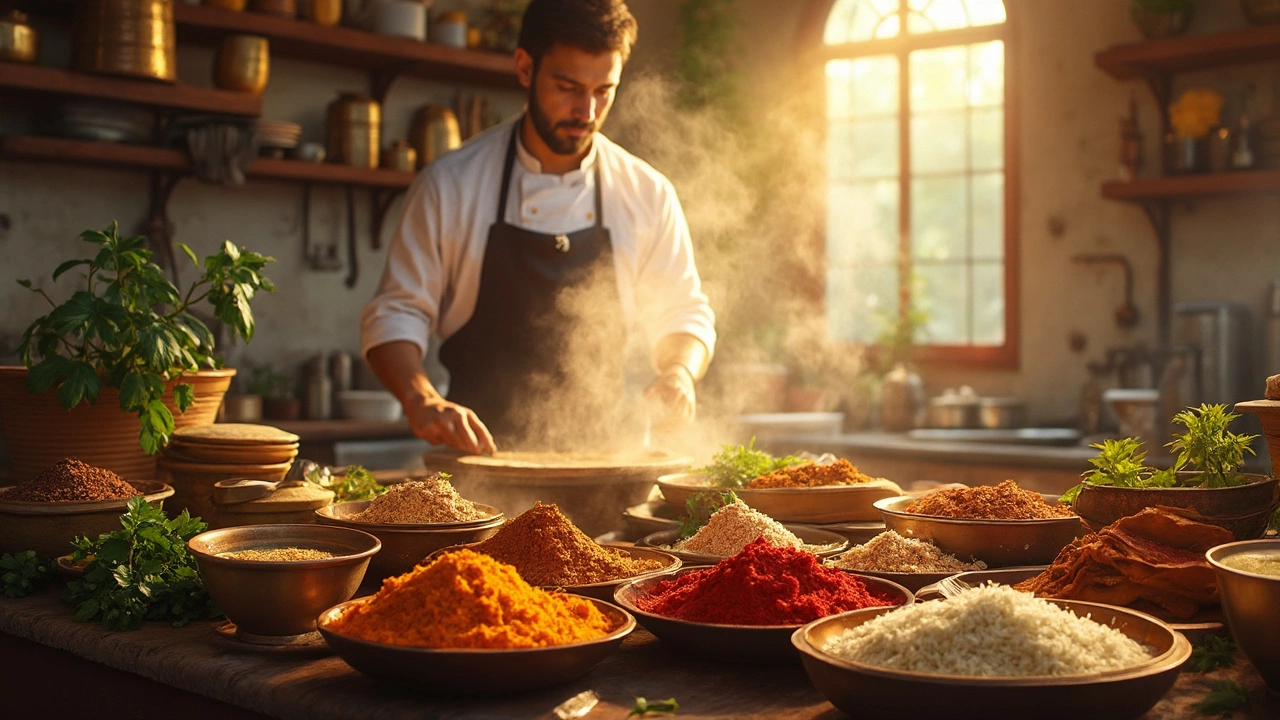Ever thought about what's likely cooking up in most Indian kitchens today? Spoiler alert: It's probably rice or wheat. These two champs aren't just foods; they're more like the backbone of most Indian meals. No matter where you go in India, chances are, you'll find these staples gracing the dining table.
Picture this: A steaming plate of rice or a fluffy chapati—simple yet integral to millions. Rice takes on many forms, from plain basmati served with dal to biryanis loaded with rich flavors. Then there's wheat, making its presence felt as soft chapatis or crispy parathas. It's not just about satiation; it's about tradition and connecting with the roots.
Now, delve deeper, and you’ll bump into lentils, or 'dal.' This humble dish might just be India's secret protein weapon. It's comforting, it's hearty, and believe it or not, it's superbly adaptable. Depending on the region, the kind of pulse used and the spices can vary drastically, lending each dish a unique twist.
- Staple Foods: Rice and Wheat
- Lentils: The Protein Powerhouse
- Diversity in Regional Dishes
- Spices: The Heart of Indian Cuisine
Staple Foods: Rice and Wheat
In India, rice and wheat are more than just staples; they're a way of life. Walk into any home, and odds are, you'll see rice bubbling in a pot or wheat being rolled out into fresh chapatis. These aren't just meals on a plate but a shared cultural experience that connects millions of households, from bustling Mumbai to serene Kerala.
Rice is a major player in southern and eastern India, where it’s the main dish in states like West Bengal, Kerala, and Tamil Nadu. Here, it's all about variety, with everything from long-grain basmati to short-grain sona masuri making an appearance. Whether it’s the fragrant biryani or the humble curd rice, these dishes are a staple part of the regional diet.
Switch gears to the north and you'll find wheat reigning supreme. Many north Indians start their day with piping hot parathas or soft naan. Wheat-based foods are everywhere, and they come in endless varieties—think roti, naan, puri, and even desserts like atta halwa.
| Region | Main Staple |
|---|---|
| North | Wheat |
| South | Rice |
| East | Rice |
| West | Both |
This reliance on rice and wheat isn't just a dietary habit; it's an economic powerhouse, too. India is one of the world's largest producers of both, making them a crucial part of the country's agricultural landscape. Farmers are the unsung heroes, working tirelessly to keep our plates full with these vital grains.
So, next time you enjoy a hearty plate of rice or a warm roti, you're not just having a meal. You're partaking in a deep-seated cultural tradition shared by an entire nation, rich in flavor and history.
Lentils: The Protein Powerhouse
When it comes to a plant-based diet in India, lentils are the real MVPs. Known as 'dal' in Hindi, these tiny pulses pack a big punch. They're not just tasty but crucial for a balanced diet, especially in a country where many people follow vegetarian or vegan lifestyles.
Why are lentils so popular? Well, let's start with their nutrition profile. Lentils are loaded with protein, which is essential for maintaining muscle and energy levels. Not to mention, they're a fantastic source of iron and fiber, which keep your digestion smooth and your blood pumping efficiently. For vegetarians in India, lentils are a daily dose of nutrition. So, when we're talking Indian food, you can bet lentils aren't far behind.
Another reason they reign supreme is their versatility. Lentils come in different hues like red, yellow, green, and black. Each type of lentil brings something unique to the table. Red lentils cook fast and are perfect for making a quick dal curry, while black lentils take center stage in rich, creamy dishes like Dal Makhani. If you've ever had a bowl of hot, spicy sambar, you're enjoying lentils at their best!
For some interesting numbers, check this out:
| Type of Lentil | Cooking Time (minutes) | Common Dishes |
|---|---|---|
| Red Lentils | 15-20 | Masoor Dal |
| Green Lentils | 25-30 | Green Lentil Salad |
| Black Lentils | 35-40 | Dal Makhani |
| Yellow Lentils | 20-25 | Dal Tadka |
Cooking with lentils isn't rocket science. They blend perfectly with the vibrant spices that India is famous for. Turmeric, cumin, and coriander often find their way into lentil dishes, adding color and aroma. And let's not forget the tadka—hot oil with spices and herbs poured over cooked lentils. It's the magic touch that transforms a simple dish into a family favorite.
If you haven't tried cooking with lentils yet, now's the time. They're affordable, cooking them is hassle-free, and the nutritional benefits are immense. Plus, they’re a staple in the Indian cuisine enjoyed by millions every day.

Diversity in Regional Dishes
Here’s the thing about India: it's almost like a culinary chameleon with its amazing variety across regions. Each part of this massive country brings something unique to the table, making Indian cuisine an absolute flavor fest.
Take, for example, the spicy curries of the South where coconut and tamarind are stars in the kitchen. Whether it's a creamy sambar from Tamil Nadu or a spicy seafood curry from Kerala, the southern states of India love their dishes zesty and aromatic.
Head over to the North, and you’ll find a love for dairy and hearty gravies. Think about butter chicken and paneer tikka. Punjab and its neighbors bring out these rich, comforting flavors that warm your soul. Besides, they make naan that’s thick and satisfying, sometimes even stuffed, making wheat a staple in such meals.
West India has its array of unique tastes, too. Maharashtra's street snacks like pav bhaji and vada pav are loved across all of India. Meanwhile, the western state of Gujarat strikes a balance with its slightly sweet vegetarian dishes, creating culinary joy that's unlike anything else.
Over in the East, Bengal is renowned for its love of fish and rice, but they have a sweet tooth too. Have you heard about their desserts like roshogolla and sandesh? These sugary delights are nothing short of iconic.
This regional variety means you’re not just eating food; you’re exploring a vibrant culture every time you try a different dish. It’s no wonder that Indian food never gets boring; there’s just so much to taste and experience!
Spices: The Heart of Indian Cuisine
When you think of Indian food, it's hard not to picture a colorful array of spices. Ever wondered why an Indian kitchen might feel like a vibrant spice market? That's because these spices do more than just flavor the food; they tell stories of tradition, culture, and sometimes, a touch of magic.
Spices like cumin, coriander, and turmeric are the usual suspects, each bringing its own flair. Turmeric, known for its bright yellow hue, is not just a cooking essential but also hailed for its health benefits. It’s like the cool kid with multiple talents. Cumin seeds, on the other hand, add a warm, earthy flavor to dishes and can be found sizzling in oil in kitchens across India.
Pepper, once dubbed as 'black gold,' has traveled through Indian history as a prized commodity. Ginger and garlic, though not exactly spices, often join this aromatic club, kicking the aroma up a notch. India doesn’t just add a ‘pinch’ of these; they often serve as the base that’s non-negotiable.
Then there’s garam masala, a blend that’s pretty much the icing on the cake for many spicy dishes. Almost every Indian household has its own version of this blend. What’s common? No two garam masalas are ever quite the same.
The use of spices varies widely across the country. For instance, the spicy curries of Rajasthan use more red chili, while the subtle coconut-laced curries of Kerala embrace a milder profile. Check out this quick look at a sample of spices used across different states:
| State | Common Spices |
|---|---|
| Punjab | Cumin, Carom Seeds, Cloves |
| Goa | Coconut, Pepper, Tamarind |
| Bengal | Panch Phoron, Mustard, Nigella Seeds |
The beauty of India's cuisine is its ability to blend these spices seamlessly. Each dish is like a symphony—you don't just taste it; you experience it. You'd be amazed at how these spices bring people together over a meal that’s much more than just food.
